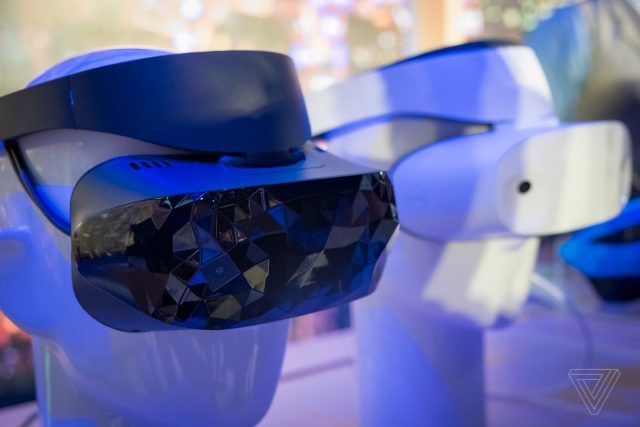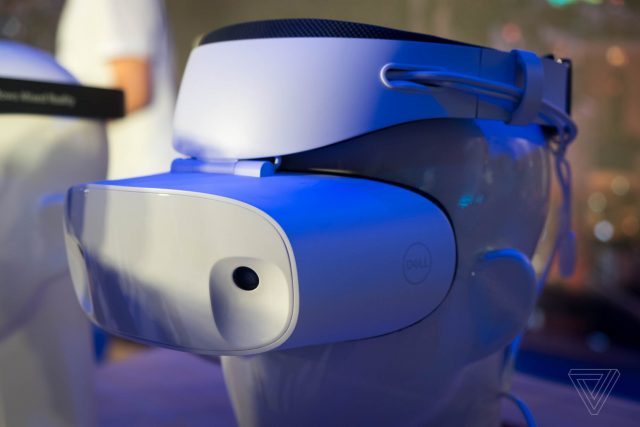Today at Computex 2017, the annual IT expo held in Taipei, Taiwan, Microsoft revealed more from their line-up of affordable Windows ‘Mixed Reality’ headsets, including Asus’ headset and an updated design from Dell.
While solid specs or pricing information aren’t available for either headset just yet, the company today revealed Asus’ headset which sports an interesting low-poly front cover panel. Microsoft says in their blogpost that the headset was designed with an ergonomically adjustable strap that can be adjusted with a single hand. The company further says that Asus is working with Microsoft to make the headset “fast, powerful, and ultra-light with a six degrees of freedom (DOF) tracked motion controller, for an incredible, immersive MR experience.”
The Windows 6 DOF motion controller was first announced at the company’s annual Build dev conference, and utilizes the headsets’ inside-out, positional tracking sensor tech.


Dell’s headset has undergone a noticeable change from when it was first publicly shown back at CES earlier this year, now featuring a remodeled front cover panel with indented sensor mounts and black head strap accents. Microsoft says the headset is designed by the same team that creates their premium XPS and Alienware PCs. The headset features cable routing, replaceable cushions and a halo-style headband with flip-up visor.
Microsoft’s Windows Mixed Reality (formerly called ‘Windows Holographic’) is the company’s immersive platform built on the foundation laid by their HoloLens AR headset. The platform features an operating environment—native to Windows 10 devices—that essentially allows compatible headsets to run any Universal Windows Platform (UWP) app. Microsoft says that a staggering 20,000 UWP apps are already available for Mixed Reality headsets. Compatible devices, first announced last December, include headsets from Asus, Acer, Dell, HP, Lenovo and Chinese firm 3Glasses.
As for computer hardware specs, Microsoft and Intel have partnered on a platform specification for these headsets so they’ll be able to “scale across mainstream Intel architecture platforms natively on [Intel’s CPU-integrated] HD Graphics,” by the end of 2017. That means there’s no need for a high-end dedicated GPU like with the Oculus Rift or HTC Vive.
Microsoft maintains that its Mixed Reality headsets will be available as early as holiday season. Acer ($299) and HP ($329) are now available for pre-order through the Microsoft Store for developers in the US (Acer, HP) and Canada (Acer, HP).
No concrete specifications have been published by either Dell or Asus regarding their respective headsets, although we wouldn’t be surprised if they look something like Acer and HP’s.
HP Headset Specs
- Two high-resolution liquid crystal displays at 1440 x 1440
- 2.89” diagonal display size (x2)
- Front hinged display
- Double padded headband and easy adjustment knob for all day comfort
- 95 degrees horizontal field of view
- Display refresh rate up to 90 Hz (native)
- Built-in audio out and microphone support through 3.5mm jack
- Single cable with HDMI 2.0 (display) and USB 3.0 (data) for connectivity
- 4.00m/0.60m removable cable
- Inside-out tracking
Acer Headset Specs
- Two high-resolution liquid crystal displays at 1440 x 1440
- 2.89” diagonal display size (x2)
- Front hinged display
- 95 degrees horizontal field of view
- Display refresh rate up to 90 Hz (native)
- Built-in audio out and microphone support through 3.5mm jack
- Single cable with HDMI 2.0 (display) and USB 3.0 (data) for connectivity
- Inside-out tracking
- 4.00m cable
Update 31/05/17 18:00ET: updated to include specs of HP and Acer headsets.



